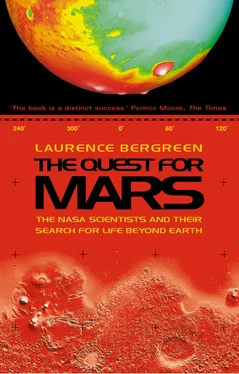Jim once mentioned to me that his colleagues considered him a bit eccentric. After pondering his disclaimers and warnings concerning Surtsey, I recalled a strange story I’d heard about him. In the heyday of the Apollo program, NASA was thinking seriously about sending people to Mars, yet the agency hesitated. Guiding a robotic spacecraft to the Red Planet is an intricate, ambitious, and unpredictable undertaking; a human mission would be far more risky and complex. NASA was stymied by the problem of getting its astronauts home. Jim came up with a unique solution: he offered to go to Mars on a one-way basis.
When I asked Jim about this story, he was mildly abashed. “I’m not proud of this now, but when I was younger, before I married and had kids, I volunteered to go.”
“One way?”
“Well, yes. The only way you could get a man there was one way. It would be too costly to get him back to Earth. So I would go there, have enough life support to explore and survive for two years, and then …”
“And then?”
“That would be all. And it would have been worth it, the scientific returns would have been spectacular, but that was before I had kids. Now I have other responsibilities I didn’t have then.”
The thin tin walls of the Heimaey airport terminal start to vibrate. There’s a sound almost below the threshold of hearing. We feel it in our guts as it gets louder and more intense. Thwacka-thwacka-thwacka … Rotors whirring, the Iceland Coast Guard helicopter, an impressively large and sturdy Bell Jet Ranger, descends into view. It is a noisy piece of equipment, manned by a crew outfitted with Day-Glo orange flight suits. These are the men of the Iceland Coast Guard, and they swarm around us like giant orange insects. A small group of Icelandic botanists has joined us, and our little group approaches the helicopter, deafened by the whine of the motor and the thumping of the rotor. A crew member, smiling crazily, hands each of us a life vest and a helmet equipped with a microphone. I place the helmet snugly over my head, and the unbearable thwacka-thwacka-thwacka subsides to a distant drumbeat. We strap ourselves into the seats, and the helicopter slowly rises from tarmac to a height of about six feet. We delicately revolve until the nose suddenly pitches forward, and we take off like a shot. This is flying. We swoop over the ocean at an altitude of about 500 feet, until we reach the island of Surtsey, fifty miles from nowhere. From the air, the place looks so barren and primitive and devoid of anything recognizable that even Heimaey, by comparison, seems civilized. The jagged gray lava formations of Surtsey rise to greet us. The helicopter sets down lightly on a concrete landing pad considerably smaller than my living room.
Less than twelve hours before, I was sitting in the back of a taxi cab in New York City, and Jim was fighting traffic on the way to Baltimore-Washington International Airport. It is now 10:30 AM local time on a rare, beautiful morning on sub-arctic Surtsey. Our coordinates are 63° 13” North, 20° 31” West.
The rotors slow almost to a stop. We emerge from the helicopter and wave merrily to the crew. The helicopter begins to whine, the rotors fling gritty volcanic ash into the air, and the machine lifts off.
It tilts toward the mainland and disappears, leaving a therapeutic silence.
We are alone on the newest place on Earth.
The temperature is in the high fifties, about as warm as it gets on the surface of Mars. True, the atmosphere here is saturated with oxygen and the gravity is approximately two-and-a-half times greater than the Red Planet’s, but as far as Jim is concerned, he’s on Mars.
Jim believes this is a particularly auspicious day to begin his mission, since July 20 is “Space Exploration Day,” also known as “Moon and Mars Day.” On this date in 1969, the Apollo 11 astronauts stepped onto the lunar surface. Seven years later to the day, the Viking 1 lander transmitted the first images of the plains of Chryse to Earth. Quite a date, when it comes to planetary exploration. Some day, he believes, July 20 will be designated a national holiday for space exploration.
The botanists disperse ahead of us. Although he is exhausted from a sleepless night, Jim heads out with a bundle of topographic maps under one arm and a pair of bright orange Swarovski laser binoculars around his neck. “They are good to three-tenths of a centimeter. I have about fifteen different programs I can set it on, and if I want, I can connect it to my laptop,” he says. He wears hiking shoes designed for walking across lava, an olive drab NASA flight jacket, and a white baseball cap bearing the legend “Mars Observer,” a reference to the billion-dollar NASA spacecraft that vanished in 1993. No trace of it has ever been found, nor has a wholly satisfactory explanation been offered for its disappearance. Jim refers to the incident as an “act of God,” and wears this cap as a casual memorial to the lost mission.
As he sets out on this glorious Surtsey morning, he experiences an overwhelming sense of déjà vu . The last time he was here was 1991, and now he suddenly feels as though he’s home again, and he wipes his eyes. There’s a spiritual dimension to his scientific exploration that he can’t quite put into words. It’s an epiphany – a scientific epiphany, if there can be such a thing. “I felt as if I were back at a good place for learning and experiencing how life gains a foothold on a previously unborn, sterile world,” he later told me, when he was better able to verbalize, but now, at the moment he sets out, it’s the adrenalin rush he’s feeling, the intoxicating sense that the world, or this little volcanic part of it, anyway, belongs to him for the time being. There’s so much going on in his mind – calculations, memories, nascent hypotheses – that I think of Garvin as a highly emotional computer.
He allows the nostalgia to wash over him, and goes to work. Although Surtsey looks stonily barren from the air, close inspection yields different results. “Observing change is the central theme of Earth and planetary science,” Jim tells me. “What is changing? What has changed? Has life on the Red Planet – if it’s there, that is – changed or been changed by Martian conditions over time? Have environments on Mars eradicated the footholds of life that may have been established at one or more times in Martian history? With Surtsey, I am struck by the incredible pace of biological change in only seven years. What appeared as a nearly sterile, Mars-like vista in 1991 is now an alien landscape complete with kitchen-table-sized mounds of flourishing higher-order plants, dunes covered by grasses.” Jim mentions that ecological succession has changed the face of Surtsey at a rate ten, or even a hundred, times faster than typical terrestrial landscapes, and perhaps a million times faster than change on Mars. Thanks to the action of wind and water, Surtsey is destined to vanish beneath the surface of the ocean almost as quickly as it arose. “I’m going to have an equation by October that will contain the predictive lifetime for Surtsey,” he says. “We’ll have the first landscape volume erosion rate for an isolated volcanic island.” If the present erosion rates hold, Jim predicts Surtsey will vanish beneath the waters of the North Atlantic by 2045, and his subsequent calculations confirm this date. Think of this process as geological time-lapse photography. A world arises and vanishes before your eyes.
Ahead lies an impossibly steep curving wall of solid rock, 460 feet high; to the left, a craggy, broken crater – a tephra ring about fifty yards across. A tephra ring is a partial crater formed as exploding volcanic ash falls to the ground in a semicircle, usually molded by the prevailing winds, which on Surtsey can be fierce. Geology-speak is a Babel of languages. Tephra is Greek for ash. Lava is Hawaiian. Many other terms are Icelandic, which is among the oldest continuously spoken languages in the West, the language of the Sagas, and, at times, the language of geology.
Читать дальше












